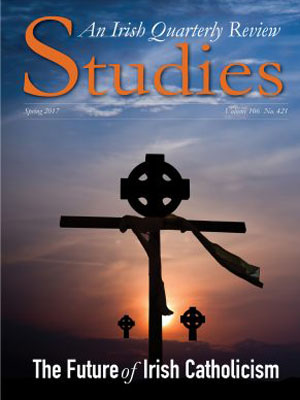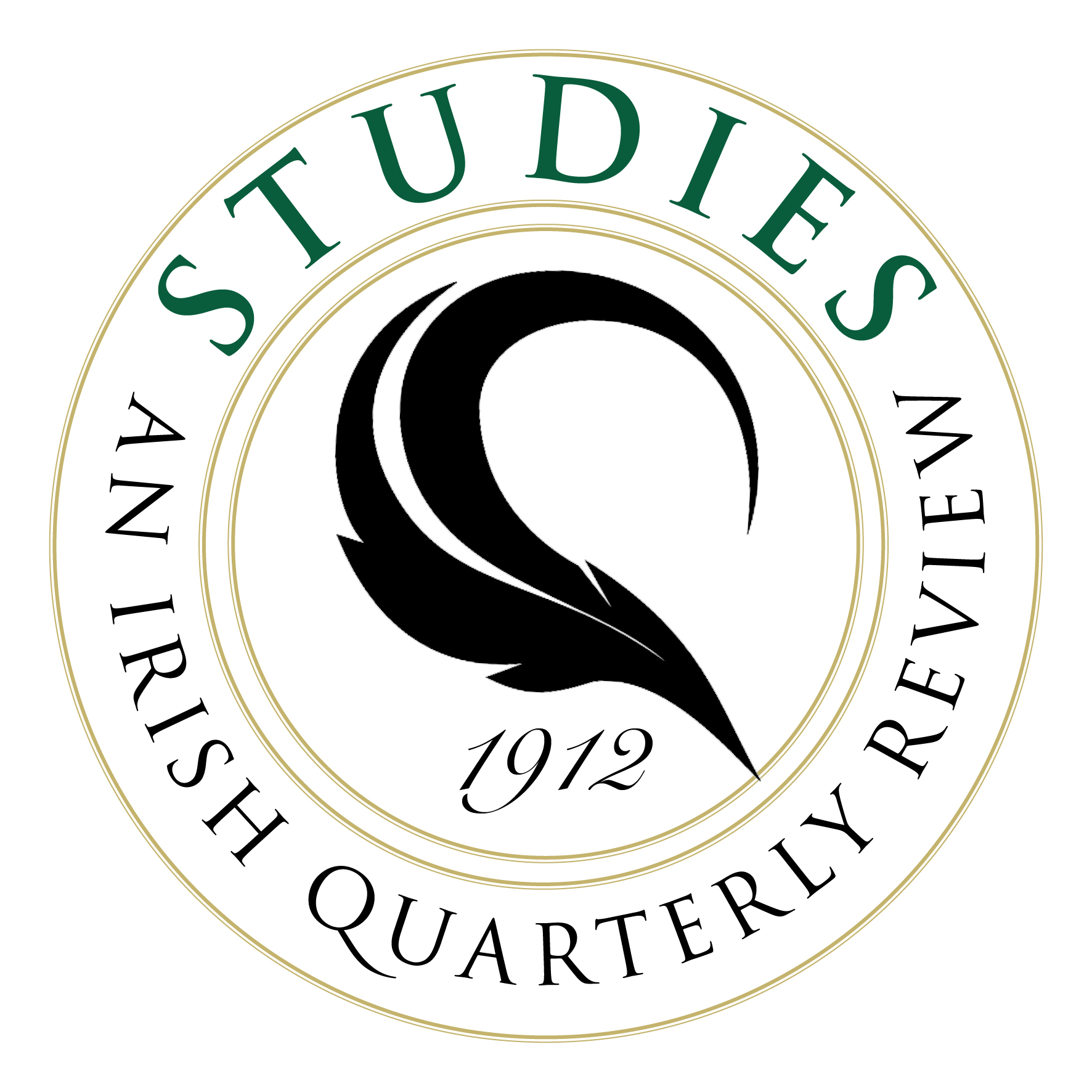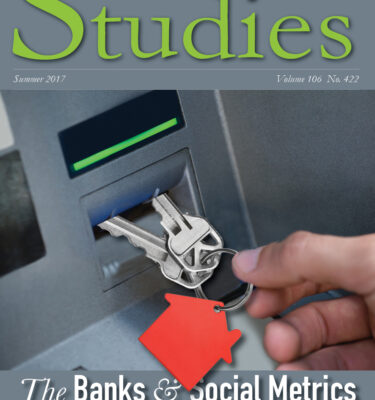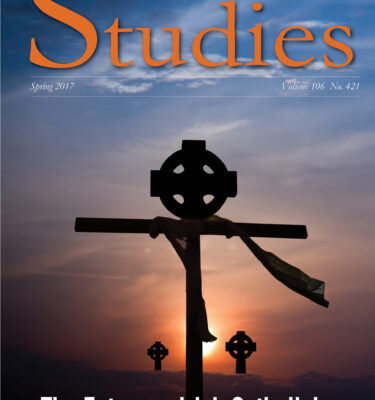Spring 2017
Showing all 9 results
The Future of Irish Catholicism: Spring 2017 | Volume 105 | No. 421

In late 1952, a contemporary observer felt able to describe Ireland as ‘the most Catholic country in the world’. Yet, in December 2011, less than seven decades later, the current Archbishop of Dublin, Dr Diarmuid Martin, could tell an audience in Cambridge that the Irish Catholic Church in our time runs the risk of becoming an ‘irrelevant minority culture’. Are we reaching ‘the end of Irish Catholicism’, to invoke the title of a book published in 2003? That book’s author, Dr Vincent Twomey, then Professor of Moral Theology in St Patrick’s College, Maynooth, appended a question mark – he was not, or not yet, proclaiming the Church’s demise. But the question has not gone away in the years since, as Archbishop Martin’s warning makes clear. In this issue of Studies, Vincent Twomey and a number of other commentators, writing from different perspectives, take up the question of the decline of Irish Catholicism again.
The opening essay by Dr Gerry O’Hanlon, originally written for our Italian sister-publication La Civiltà Cattolica, gives a characteristically masterly overview of the physiognomy of Catholic decline in Ireland, its struggles to cope with ‘the challenges of late modernity’ and the possible path to renewal. Citing fellow theologian, Dr Dermot Lane, he writes that ‘the process of secularisation (now well advanced in Ireland) has resulted in the emergence of a purely “immanent frame” of reference, an “exclusive humanism”, a “disenchanted universe” without reference to the Transcendent’. But he rejects any nostalgic hankering after the traditional forms and practices of another age. ‘True tradition’, he writes, ‘surely knows how to read the signs of the times, in fidelity with what went before, and to discern what in the culture is to be respected and used to reform the Church and what is to be rejected?’
Equally, ‘Post-Catholic Ireland need not fall prey to the dominant trend of de-institutionalisation and individualisation, with an extra-institutional religion that is practised with vitality only outside the institutional Catholic Church, and an institutional remnant that is culturally irrelevant.’ But, as he adds, ‘without a serious commitment to reform and renewal, that seems the likely future’. A key word in his earlier comment is ‘discernment’, so central to Ignatian spirituality and so often on the lips of Pope Francis. But discernment requires a forum in which it can take place, a discerning community, so palpably lacking in the Irish Church at large. What is needed, Gerry O’Hanlon writes, is ‘a synodal form of Church at all levels’, something he and others have been calling for consistently for at least a decade. This, it can be argued, is where the shared discernment by the whole Church, so urgently needed, might at last take place.
On the evidence of what sociologist-professor, Tom Inglis, of University College Dublin, reports in these pages, the movement towards ‘de-institutionalisation and individualisation’ and the Church’s lapse into cultural irrelevance is already well-advanced. His findings are based on his extensive research into religious attitudes and practices in Ireland, reflected most recently in his Meanings of Life in Contemporary Ireland: Webs of Significance, published in 2014. As well as tracking the familiar decline of the Church in Irish life, he suggests, on the basis of his research, that not only do Irish people no longer look to the Church of their upbringing as a place or ‘site’ where they practise religion, nor even as a source of meaning and moral guidance in their lives – they tend, in his experience, not to probe the deeper questions about ultimate meaning and transcendence very much at all. The enthusiasm and depth of devotion of two non-Catholic respondents, an African Christian and a Muslim, stood out in stark contrast to the apparent indifference of his supposedly Catholic interlocutors. When Dr Inglis led the conversation towards areas where people might have been expected to allude to religious inspiration, they failed to do so. Sport, it seems, is of more compelling interest than God.
Last June, the Loyola Institute of Trinity College Dublin held an international interdisciplinary conference under the provocative rubric, ‘The Role of Church in a Pluralist Society: Good Riddance or Good Influence?’ Studies, whose principal purpose from its foundation has been, in effect, to promote a dialogue between faith and culture in Ireland, has already been pleased to publish several of the Loyola Institute papers, with the kind permission and assistance of the conference organisers, Dr Con Casey, Dr Fáinche Ryan and their colleagues, two more of the papers appear in the current issue.
The first of these is by Tom Inglis’ fellow sociologist of religion, Dr Gladys Ganiel, who gives a brief account of her recently published book, Transforming Post-Catholic Ireland: Religious Practice in Late Modernity. Based on her research, she proposes that Ireland is now, properly, ‘post-Catholic’. She is at pains to insist that, she is ‘not saying that the island of Ireland was once Catholic, and now it is not. Rather, a dominant, traditional form of Irish Catholicism is being displaced’. Many, including those brought up as Catholics, ‘now often define their faith in opposition or contrast to Catholicism’. Quoting Jürgen Habermas, she speaks of ‘a shift in consciousness’ among Irish people and suggests that ‘to characterise the island as post-Catholic … captures something of the momentousness and drama of the religious change that has occurred’. ‘Who now’, she asks, ‘speaks of “holy, Catholic Ireland” as anything but a period in this island’s history?’ Who, indeed! Ireland has become something of a ‘market’ in religious terms, with a much wider range of religious options available to an increasingly diverse population. Part of this pattern is the growth of ‘extra-institutional’ religion, a point elaborated by Dr Inglis, ‘new religious spaces’, as she puts it, ‘that are being created (or discovered) within Ireland’s post-Catholic environment’.
Vincent Twomey’s concerns, as reflected in his paper in this issue of Studies, have scarcely changed since the publication of his book in 2003. Why has the Catholic Church in Ireland, with its rich history and tradition, proved so unable to face the many challenges which have been confronting it since at least the 1950s (if not, in truth, from much earlier) and what might be some of the solutions to these challenges? Much of the publicity the book attracted when it first appeared related to his suggestion that twenty-six dioceses on the island is far too many for a country with a population of our size. But this – however obviously desirable – seems to have acquired little traction in higher ecclesiastic circles and he does not pursue the issue in his present contribution.
He is clear that the clerical scandals, ‘at the forefront of public discourse’ at the time of his book’s appearance, ‘though they exacerbated the crisis facing the Church in Ireland … were but a symptom of that crisis, not its cause’. For him, the Church’s ‘fundamental weakness’ in this country is anti-intellectual bias, with a consequent lack of self-criticism’, and a clear link to the crisis of faith we now experience. This leads him to extensive discussion of the need for bishops – as a matter of what he insists is ‘distributive justice’ – to favour serious theological education among their clergy, specifically in the form of higher studies, corresponding to their talents and abilities, in order to lay firmer foundations for a recovery of intelligent faith in the Catholic community at large. ‘Pastoral’ considerations, he would argue, can verge towards a kind of populism and may mean little more than the pragmatic filling of gaps, at the expense of longer-term vision and the flourishing of talent. He is also – surely rightly – concerned at the state of religious education in schools. The poverty of Irish liturgical celebration (such that ‘the source and summit of the Christian life has been reduced to an obligation to be satisfied with the least pain for either priest or people’), and its consequent failure to have much appeal for younger would-be worshippers in particular, is another cause for regret.
In his concluding remarks, Dr Twomey argues that ‘the Church – the laity in particular – must find its own Catholic voice in the public square by entering into debate on all issues affecting Irish society.’ In the second Loyola Institute paper published in the present issue of Studies, Dr Gerry Whelan provides an extensive analysis of the ways in which the late John Courtney Murray’s theological reflections on religious freedom developed over a period of more than twenty-five years, including their crucial influence on the Second Vatican Council. The starting-point for Courtney Murray was, precisely, the absence of such a Catholic voice in the United States in the 1940s, which he came to link with the Church’s teaching on religious freedom. Gerry Whelan’s paper, of interest in itself, has particular relevance because of the Irish Church’s relatively poor reception of the Council. This is true of the Council in general, for which we are continuing to pay a heavy price, and true, not least, of the Council’s pioneering 1965 Declaration on Religious Freedom (Dignitatis Humanae), the importance of the Church-state questions at issue for this country, then and since, notwithstanding. In writing of the growing influence on Courtney Murray of his Jesuit confrère Bernard Lonergan, Whelan strongly underpins the concerns about the Irish Church’s historical and continuing lack of appropriate intellectual armoury and capacity to criticise itself at the highest levels expressed by other writers here.
‘Yes, we have no Bernanos’, the late writer and commentator Seán MacRéamoinn, used to say, reflecting on the paucity of intellectuals, lay or clerical, in the Irish Church, by comparison with France. One of the causes was undoubtedly the absence of theology in the university, a point alluded to in these pages. What this regrettably seems to reflect has been the fear, at least in the past, that bishops – who, in fairness, carry such heavy burdens in these difficult times – might lose control of theological discourse, even though this problem has been long since met satisfactorily elsewhere. The same fear may be one of the causes preventing the summoning of a national synod of the Church. (Another may be the apparent dysfunctionality of the Irish Episcopal Conference – a body that slavishly, time and again, elects the same two office-holders, Armagh and Dublin, to the presidency and vice-presidency and as their representatives in higher councils, looks very much as if it is stuck in some kind of rut and is arguably not fit for purpose.)
That said, the Loyola Institute in Trinity College is a hopeful sign of what can be done and may yet bear rich fruit. Patrick Maume’s careful essay on Michael Adams here is of some pertinence. Adams was a deeply-committed layman, a life-long member of Opus Dei, profoundly spiritual, theologically literate, highly articulate, undoubtedly conservative in certain ways but independent enough to transcend lazy categorisation, someone who steadfastly served the Church to the best of his ability in the public square. Over the years, as MacRéamoinn’s squib suggests, there have been too few publicly-visible men (not to mention women) of real intellectual calibre with the freedom and capacity to articulate and defend their commitment to the Church. But Michael Adams was one such. (MacRéamoinn’s near namesake, the late Louis McRedmond, was surely another.)
Finally, in the present issue, Dr Sean Brophy continues his thoughtful reflections on the transforming events of 1913-23, ‘Ireland’s decade of conflict’. As the country continues to remember that now long-past time, and its continuing impact on our present, it is salutary to recall once again the proclamation’s proud aspiration ‘to pursue the happiness and prosperity of the whole nation and all of its parts, cherishing all the children of the nation equally’. In a time of so much, and scandalously growing, inequality in countries across the globe, very much including our own, there is special poignancy in the heartfelt remarks of Fergus Finlay, chief executive of Barnardos and a former candidate for the presidency of Ireland, in a book review in these pages. On the basis of the latest available evidence, he reports, ‘one in nine of our children live in consistent poverty’. That means, ‘120,000 hungry, cold, inadequately developing children’, who ‘never seem to warrant a mention’ in news-cycles dominated by other matters.
Given the bleak recent history of some of the Catholic Church’s involvement with children, it may seem temerarious to suggest that a reinvigorated and renewed Church has too much to contribute in terms of service and witness in our country to be dismissed, by secularist clamour, from the public square. But, reckless or not, that suggestion must be made. Appearances sometimes to the contrary, historical distortions in the institution itself and contemporary misrepresentations of its full history in Ireland notwithstanding, the Church, as Gerry O’Hanlon writes here, ‘does not exist for its own sake. It is for the Kingdom and is rooted in an encounter with Jesus Christ, continuing his mission (given by the Father) through the power of the Spirit.’ It is not about power and control but to be what Pope Francis has called ‘a field hospital’ for an embattled world. For all the difficulties we face, bishops, priests and faithful alike, now is not the moment to lose hope. This is a task for all of us.
Contents
-
Two Nineteenth-Century Catholic Poets: Gerard Manley Hopkins and Aubrey de Vere
Patrick Samway SJ
Read Article Summary
€7.00 Purchase Single ArticleTwo Nineteenth-Century Catholic Poets: Gerard Manley Hopkins and Aubrey de Vere
-
The Catholic Church in Ireland Today
Gerry O’Hanlon
Read Article Summary
€7.00 Purchase Single ArticleThe Catholic Church in Ireland Today
-
Church and Culture in Catholic Ireland
Tom Inglis
Read Article Summary
€7.00 Purchase Single ArticleChurch and Culture in Catholic Ireland
-
Ireland as a Post Catholic Religious Market? The Role of Extra Institutional Religion
Gladys Ganiel
Read Article Summary
€7.00 Purchase Single ArticleIreland as a Post Catholic Religious Market? The Role of Extra Institutional Religion
-
The End of Irish Catholicism? Fifteen Years On
Vincent Twomey SVD
Read Article Summary
€7.00 Purchase Single ArticleThe End of Irish Catholicism? Fifteen Years On
-
Michael Adams Censorship and Catholic Activism
Patrick Maume
Read Article Summary
€7.00 Purchase Single ArticleMichael Adams Censorship and Catholic Activism
-
John Courtney Murray on Church and State
Gerard Whelan SJ
Read Article Summary
€7.00 Purchase Single ArticleJohn Courtney Murray on Church and State
-
Ireland’s Decade of Conflict 1913-23
Sean Brophy
Read Article Summary
€7.00 Purchase Single ArticleIreland’s Decade of Conflict 1913-23




 +353 1 676 7491
+353 1 676 7491 
